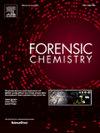Development and comparison of reversed-phase ultra high-performance liquid chromatography (RP-UHPLC) and hydrophilic interaction liquid chromatography (HILIC) approaches to the analysis of regioisomeric fluorofentanyl derivatives and related compounds
IF 2.2
3区 医学
Q2 CHEMISTRY, ANALYTICAL
引用次数: 0
Abstract
This study describes the development and comparison of low, intermediate and high pH gradient RP-UHPLC-MS/MS with that of gradient HILIC-MS/MS analysis for a range of fluorofentanyl derivatives including four families of ortho-, meta- and para-regioisomers. High pH RP-UHPLC-MS/MS using an ammonium hydroxide and methanol gradient on a high pH stable SuperC18 column at low temperature was demonstrated to be the most successful chromatographic mode for separating 26 analytes including: regioisomeric fluorofentanyls (n = 10); fentanyl analogues (n = 10), despropionyl precursors (n = 4) and two commonly encountered related substances (heroin and xylazine). Low and intermediate pH RP-UHPLC failed to afford separation of many of the fluorofentanyl regioisomers on stationary phases possessing complementary selectivity with either acetonitrile or methanol over a wide temperature range. HILIC on a bare silica column using an acetonitrile and ammonium acetate / acetic acid gradient provided good separation of fluorofentanyl regiosiomers except for the despropionyl series. High pH gradient RP-UHPLC was demonstrated to provide orthogonal chromatographic selectivity to that of HILIC in the gradient analysis of 18 fentanyl and related substances. Seven isobaric fluorofentanyl structural isomers could be readily discriminated from the unique fragmentation ions obtained using positive electrospray ionization MS/MS. The optimum high pH RP-UHPLC chromatographic conditions for the separation of the fluorofentanyls was equally successful for the rapid separation of a wide range of fentanyl regio- and structural isomers.

反相高效液相色谱法(RP-UHPLC)与亲水性相互作用液相色谱法(HILIC)在氟芬太尼区域异构体衍生物及相关化合物分析中的应用及比较
本研究描述了低、中、高pH梯度RP-UHPLC-MS/MS与梯度HILIC-MS/MS分析的发展和比较,用于一系列氟芬太尼衍生物,包括四个家族的邻位异构体、间位异构体和准区域异构体。高pH RP-UHPLC-MS/MS使用氢氧化铵和甲醇梯度在高pH稳定的SuperC18柱在低温下被证明是分离26种分析物的最成功的色谱模式,包括:区域异构体氟芬太尼(n = 10);芬太尼类似物(n = 10),地丙酰前体(n = 4)和两种常见的相关物质(海洛因和噻嗪)。在较宽的温度范围内,低pH和中等pH的RP-UHPLC无法在与乙腈或甲醇具有互补选择性的固定相上分离许多氟芬太尼区域异构体。在裸硅柱上使用乙腈和乙酸铵/乙酸梯度的HILIC可以很好地分离氟芬太尼区域异构体,但地丙基系列除外。高pH梯度RP-UHPLC对18种芬太尼及其相关物质的梯度分析具有较好的正交选择性。利用正电喷雾电离质谱联用技术可以很容易地从分离得到的独特的碎片离子中区分出7种氟芬太尼结构异构体。高pH反相高效液相色谱法分离氟芬太尼的最佳条件同样成功地快速分离了广泛的芬太尼区域和结构异构体。
本文章由计算机程序翻译,如有差异,请以英文原文为准。
求助全文
约1分钟内获得全文
求助全文
来源期刊

Forensic Chemistry
CHEMISTRY, ANALYTICAL-
CiteScore
5.70
自引率
14.80%
发文量
65
审稿时长
46 days
期刊介绍:
Forensic Chemistry publishes high quality manuscripts focusing on the theory, research and application of any chemical science to forensic analysis. The scope of the journal includes fundamental advancements that result in a better understanding of the evidentiary significance derived from the physical and chemical analysis of materials. The scope of Forensic Chemistry will also include the application and or development of any molecular and atomic spectrochemical technique, electrochemical techniques, sensors, surface characterization techniques, mass spectrometry, nuclear magnetic resonance, chemometrics and statistics, and separation sciences (e.g. chromatography) that provide insight into the forensic analysis of materials. Evidential topics of interest to the journal include, but are not limited to, fingerprint analysis, drug analysis, ignitable liquid residue analysis, explosives detection and analysis, the characterization and comparison of trace evidence (glass, fibers, paints and polymers, tapes, soils and other materials), ink and paper analysis, gunshot residue analysis, synthetic pathways for drugs, toxicology and the analysis and chemistry associated with the components of fingermarks. The journal is particularly interested in receiving manuscripts that report advances in the forensic interpretation of chemical evidence. Technology Readiness Level: When submitting an article to Forensic Chemistry, all authors will be asked to self-assign a Technology Readiness Level (TRL) to their article. The purpose of the TRL system is to help readers understand the level of maturity of an idea or method, to help track the evolution of readiness of a given technique or method, and to help filter published articles by the expected ease of implementation in an operation setting within a crime lab.
 求助内容:
求助内容: 应助结果提醒方式:
应助结果提醒方式:


